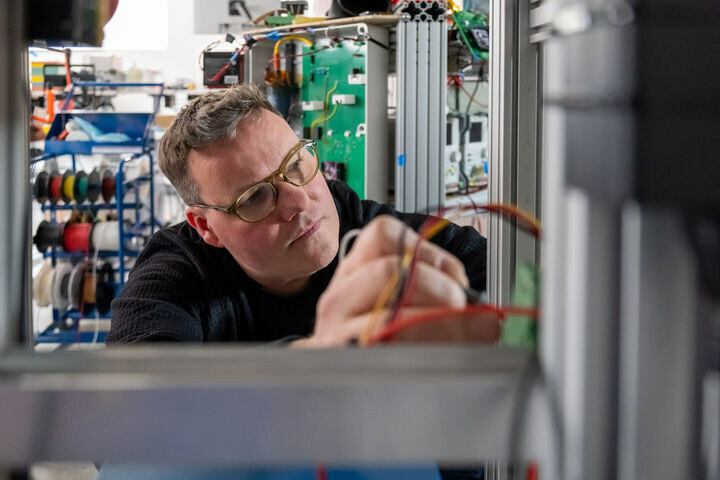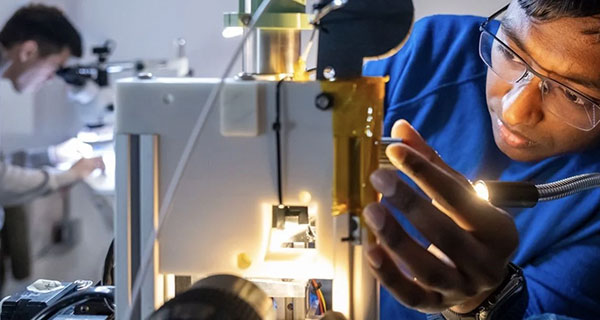Metal 3D printing startup Fluent Metal has launched out of stealth after raising $5.5 million in venture capital funding.
The new company has been founded to develop and commercialize its drop-on-demand technology. This production-scale, wire-based, liquid metal printing (LMP) process reportedly produces no material waste, making it cheaper, accessible and more sustainable than existing powder-based approaches.
Fluent Metal uses inkjet printheads for a material jetting approach compatible with most metals, including heat-resistant refractory metals, and fabricates parts in a single-step process to minimize variability.
Although additional details on the company’s 3D printing technology are currently limited, Zach Vader, Co-Founder of Vader Systems, is named as one of Fluent Metal’s advisors. Through its MagnetoJet technology, Vader Systems developed the industry’s first liquid metal jet 3D printer at IMTS 2016.
The Vader Systems technology melts wire feedstock within a ceramic nozzle to create a melt pool of molten metal. An electromagnet is then used to induce a current which causes material droplets to extrude from the nozzle. Once extruded, these droplets rapidly cool, solidify, and bond layer-by-layer, creating the desired metal part.
Vader Systems’ LMJ technology was acquired by global print and digital document corporation Xerox in 2019, which later sold it to US-based metal 3D printer manufacturer ADDiTEC in 2023.
The Fluent Metal team features notable industry experience, with a number of the company’s key figures hailing from Massachusetts-based industrial 3D printer manufacturer Desktop Metal (DM). The firm’s Co-Founder and CEO, Peter Schmitt, previously served as DM’s Chief Designer. Additionally, CFO Elizabeth Linardos has formerly held positions of CFO, Strategic Advisor, and VP of Finance at the metal 3D printer OEM.
John Hart, co-founder of both Desktop Metal and digital manufacturing firm VulcanForms, is named as Fluent Metal’s founding advisor. Also offering his expertise is Chris Bangle, who has previously held the role of Chief of Design at BMW Group.

Fluent Metal enters the 3D printing market
Fluent Metal’s liquid metal 3D printing drop-on-demand process uses wire feedstock to fabricate metal parts. Multiple materials can be extruded simultaneously in liquid form through inkjet-style 3D printer heads, which then solidify and bond to form layers. Through this process, different metals can be combined to 3D print parts with complex geometries, including fully enclosed voids and internal channels.
The company claims that this 3D printing process produces zero material waste and uses less power than powder bed fusion (PBF) systems, as only the material that is needed is 3D printed. This is said to ensure greater sustainability and operational efficiency. The material changeover process is also advertised as being easy, minimizing 3D printer downtimes and simplifying the setup process.
Fluent Metal’s LMJ 3D printers are designed to safely operate on a typical factory floor or prototyping shop, with no clean room or additional safety measures needed. Therefore, the firm’s offering is said to remove the barrier of entry for metal additive manufacturing, increasing its accessibility to more manufacturers.
“Drop-on-demand technology is an elegant approach to create complex metal components,” stated Schmitt. “Whether it’s prototype iterations of an idea or production runs of a single part, Fluent Metal will provide customers with great operational and material flexibility. This freedom will unlock new creativity and problem-solving abilities across industries.”
Before its launch, Fluent Metal raised $3.5 million in a venture capital funding round led by E15 Ventures, Pillar VC and other industry angels, bringing their total funding to $5.5 million.
Philip Liang, Managing Partner at E15, commented that the commercialization of the firm’s drop-on-demand 3D printing technology will help to meet demands relating to supply chain and sustainability challenges.
“In the near term, Fluent Metal will spark the imagination of designers, engineers, and technologists to consider how rapid, on-demand production of custom metal parts could transform their capabilities. At scale, this approach will revolutionize the entire footprint and direction of industrial manufacturing,” added Liang.

Advancing liquid metal printing
Since the introduction of Vader Systems’ MagnetoJet 3D printers, efforts have been made to further develop and commercialize LMP technology into new markets.
Back in 2022, Manufacturing system and machine tool developer GROB-WERKE (GROB) announced its entry into the 3D printing industry with the launch of its GMP300 Liquid Metal Printing (LMP) system. This offering has been designed to enable the rapid fabrication of near-net-shape parts from wire feedstock in a cost-effective, material-efficient way.
The GMP300 is billed as offering a higher build-up rate than PBF, and better resolution than Directed Energy Deposition (DED). Targeted towards metalwork applications, the LMP 3D printer possesses a 300 x 300 x 300 mm³ build volume, three-axis kinematics, a top axis speed of 30m/min, and a build chamber that operates under an inert atmosphere.
Elsewhere, Researchers from the Massachusetts Institute of Technology (MIT) published a study demonstrating the benefits of LMP for large-scale construction and architecture applications. The team’s approach deposits molten aluminum onto a bed of small glass beads, with the material quickly hardening to form the desired 3D structure.
This process sacrifices surface resolution and precision for speed and can fabricate structures ten times faster and at lower costs than alternative metal 3D printing techniques. The MIT researchers claim that this study was the first to demonstrate the value of LMP for the rapid production of large-format parts for architecture and construction. A range of parts were 3D printed to support this hypothesis, including metal frames for tables and chairs.
What does the future of 3D printing hold?
What near-term 3D printing trends have been highlighted by industry experts?
Subscribe to the 3D Printing Industry newsletter to keep up to date with the latest 3D printing news. You can also follow us on Twitter, like our Facebook page, and subscribe to the 3D Printing Industry Youtube channel to access more exclusive content.
Are you interested in working in the additive manufacturing industry? Visit 3D Printing Jobs to view a selection of available roles and kickstart your career.
Featured image shows Fluent Metal Co-Founder and CEO Peter Schmitt. Photo via Fluent Metal.

